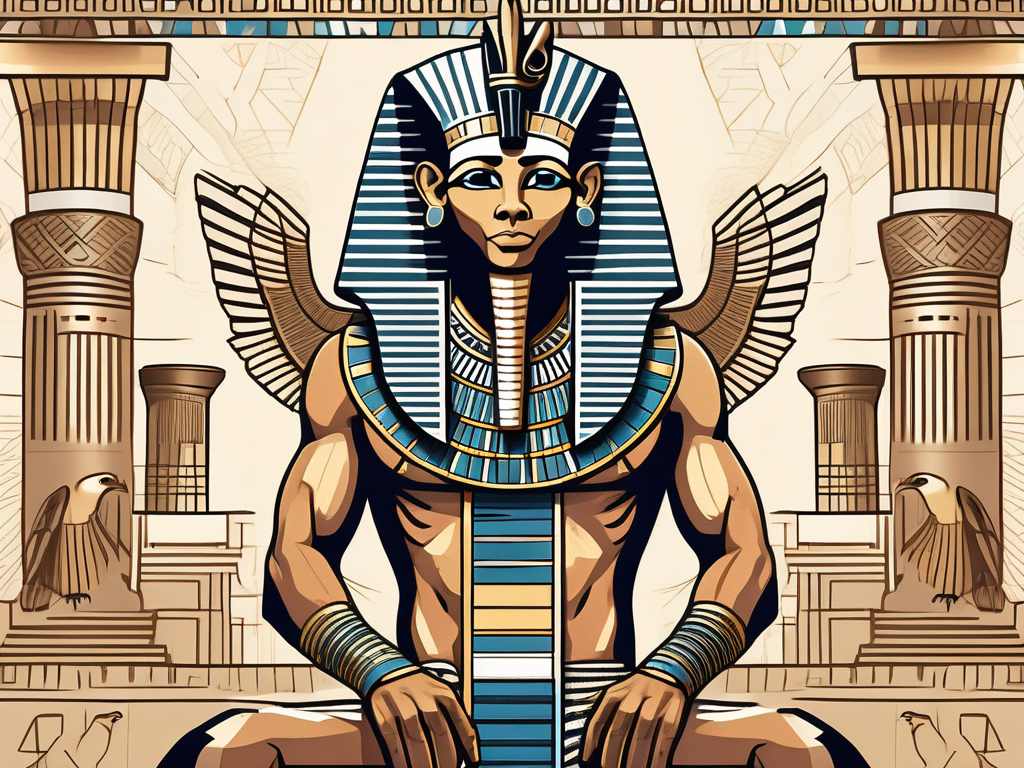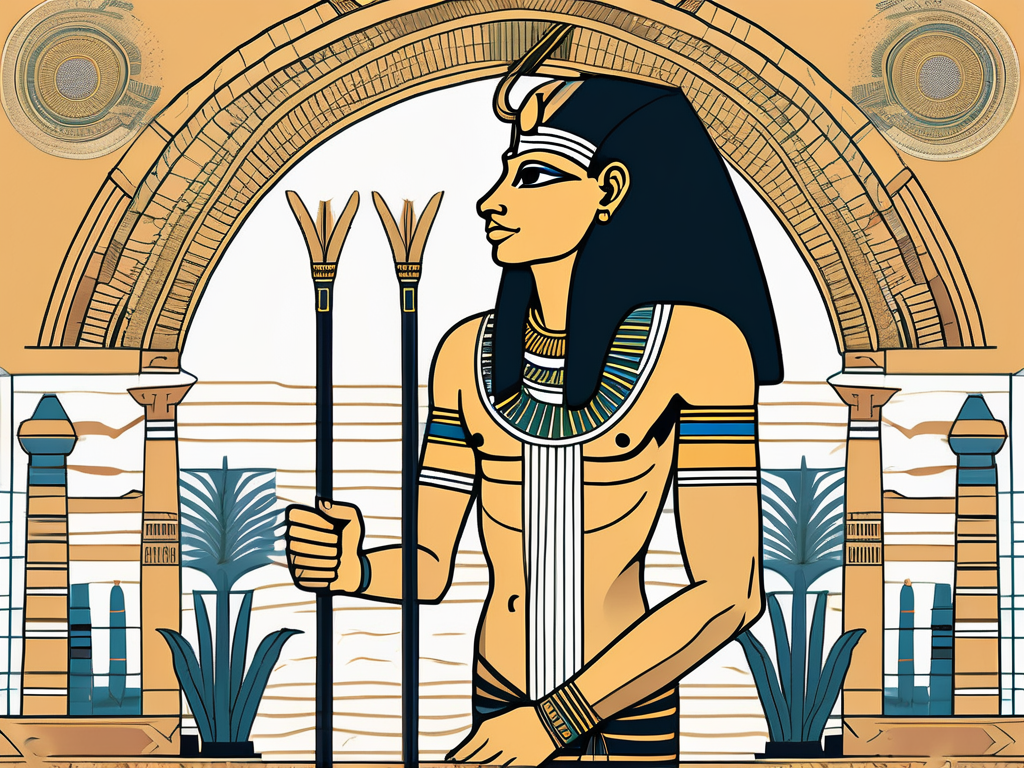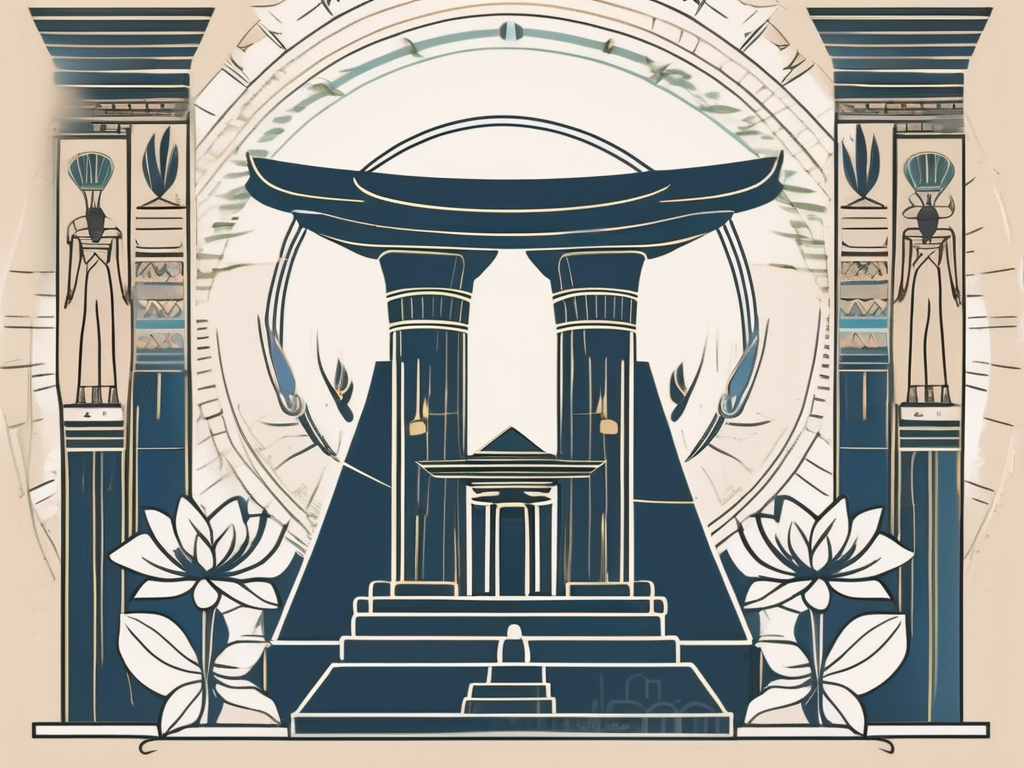In the rich tapestry of ancient Egyptian mythology, one figure stands out as a symbol of fertility and renewal: Heqet. This fascinating deity captivated the minds and hearts of the ancient Egyptians, leaving behind a lasting legacy that continues to intrigue us to this day. Let’s delve into the multifaceted aspects of Heqet’s existence and the profound impact it had on the ancient Egyptian society.
Understanding the Role of Heqet in Ancient Egypt
Heqet, often depicted as a frog-headed woman, played a crucial role in Egyptian mythology. The symbolism associated with this deity was profound and deeply intertwined with the Egyptian beliefs surrounding fertility and renewal.
One of the key aspects that Heqet represented was the idea of birth and creation. The frog, with its ability to lay thousands of eggs, symbolized the power of creation and reproduction. Heqet’s association with new life and regeneration was mirrored in the annual flooding of the Nile, which was seen as a symbol of rejuvenation and the essence of fertility.
But what exactly was the significance of Heqet’s frog-like appearance? The frog, in ancient Egyptian culture, was considered a symbol of transformation and rebirth. Just as a tadpole undergoes a metamorphosis to become a frog, Heqet represented the transformative power of birth and the cycle of life. This symbolism was further emphasized by Heqet’s association with the net-shaped headdress, which was often depicted on her head.
The Symbolism of Heqet
Heqet, with her frog-like appearance, was often depicted wearing a net-shaped headdress associated with childbirth. This headdress symbolized the protective net that was placed around infants to ensure their safety during birth. The frog’s ability to lay so many eggs also connected Heqet with the concept of abundance and the cycle of life.
Moreover, the frog was also associated with the annual flooding of the Nile. Just as the floodwaters brought life-giving nutrients to the soil, Heqet’s presence was believed to bring fertility and prosperity to the land. This connection between Heqet and the Nile flood further reinforced her role as a symbol of renewal and growth.
Heqet’s Influence on Ancient Egyptian Society
Apart from the profound symbolism associated with Heqet, this deity permeated many aspects of ancient Egyptian society. The fertility and renewal represented by Heqet were an essential part of Egyptian agricultural practices. The annual flooding of the Nile, which brought rich sediment and nutrients to the soil, was directly connected to the god’s influence.
Furthermore, Heqet’s association with childbirth and creation made her a prominent figure in the lives of Egyptian women. Many women turned to Heqet for guidance and protection during pregnancy and childbirth, believing that her divine presence would ensure a safe and successful delivery.
But Heqet’s influence extended beyond just the agricultural and maternal realms. She was also revered as a protector of the pharaoh, ensuring his well-being and the continuity of his rule. The pharaoh, as the embodiment of divine power on Earth, relied on Heqet’s blessings for a prosperous reign.
In addition, Heqet was often depicted alongside other deities, such as Osiris and Isis, further emphasizing her importance in the Egyptian pantheon. Her presence in religious rituals and ceremonies underscored her role as a bridge between the mortal and divine realms.
Overall, Heqet’s significance in ancient Egyptian society cannot be overstated. From her association with birth and creation to her influence on agriculture and maternal well-being, Heqet embodied the fundamental aspects of life and renewal. Her presence in Egyptian mythology and society served as a reminder of the cyclical nature of existence and the eternal power of regeneration.
The Mythology Surrounding Heqet
Heqet’s mythology delved into the origins of this enigmatic deity and her presence in ancient Egyptian tales and legends.
Heqet, a goddess of ancient Egypt, was revered for her association with fertility and renewal. She played a vital role in the creation of the world, according to one myth. It was believed that Heqet, along with her husband Khnum, created the first humans on a potter’s wheel. Khnum, the ram-headed god, shaped the physical form of humans, while Heqet breathed life into their bodies, symbolizing her role as the giver of life and fertility.
Heqet’s presence in Egyptian mythological tales extended beyond her role in creation. Her association with fertility and renewal saw her involvement in various divine narratives. In one such tale, Heqet assisted the divine cow, Hathor, in her role as the caretaker of the Eye of Ra. The Eye of Ra, a symbol of power and protection, was damaged, and Heqet guided Hathor in restoring it. This act symbolized Heqet’s ability to rejuvenate and heal, emphasizing her significance in the cycle of life.
Another prominent myth involving Heqet revolved around the tale of Osiris, the god of the afterlife. Osiris was murdered by his brother, Set, and it was Heqet who played a crucial role in his resurrection. Through her divine intervention, Heqet ensured the continuation of life and the cycle of rebirth. Her association with resurrection further solidified her status as a powerful deity in ancient Egyptian mythology.
Heqet’s presence in Egyptian mythology was not limited to these tales alone. She was also associated with childbirth and was often depicted as a frog-headed goddess. The frog, known for its ability to lay large numbers of eggs, symbolized fertility and the creation of life. Heqet’s association with childbirth made her a significant deity for women seeking fertility and safe deliveries.
Throughout ancient Egypt, Heqet was worshipped and revered for her role in the creation of life and her ability to bring about renewal. Her presence in mythological tales showcased her power and influence, solidifying her status as a prominent goddess in the pantheon of Egyptian deities.
Heqet’s Association with Fertility and Renewal
The significance of fertility and renewal in ancient Egyptian culture cannot be overstated. Heqet’s association with these concepts shed light on the profound beliefs held by the people of ancient Egypt.
The Significance of Fertility in Ancient Egypt
Fertility was a cornerstone of ancient Egyptian society and its agricultural practices. The fertile land along the Nile River allowed the ancient Egyptians to sow crops, ensuring a stable food supply. The annual flooding of the river symbolized not only the fertility of the land but also the cyclical nature of life itself.
The ancient Egyptians revered the Nile River as a life-giving force, attributing its fertility to the goddess Heqet. She was believed to be responsible for the abundance of crops and the prosperity of the people. Farmers would offer prayers and sacrifices to Heqet, seeking her blessings for a bountiful harvest.
Heqet’s association with fertility extended beyond agriculture. She was also closely linked to human fertility and childbirth. Ancient Egyptian women would pray to Heqet for help in conceiving and delivering healthy children. Her presence in the birthing process was believed to ensure a safe and successful delivery.
In this context, Heqet represented the vitality and abundance of the land, reflecting the importance of fertility as a vital force that sustained the entire civilization.
The Concept of Renewal in Egyptian Beliefs
Ancient Egyptians held a deep belief in the cyclical nature of life and the concept of renewal. They saw death as a gateway to a new existence, where the deceased would be transformed and continue their journey in the afterlife.
Heqet epitomized this belief in renewal, as her association with childbirth symbolized the cycle of life repeating itself. Just as a new life is born, the deceased would be reborn in the afterlife, beginning a new chapter of their eternal existence.
Heqet’s role in the concept of renewal extended beyond the afterlife. She was also associated with the annual flooding of the Nile River, which brought new layers of fertile soil to the land. This cycle of flooding and receding waters represented the constant renewal and rejuvenation of the earth.
Furthermore, Heqet was often depicted as a frog, a creature associated with water and transformation. The frog’s ability to undergo metamorphosis from tadpole to adult mirrored the concept of renewal and transformation in ancient Egyptian beliefs.
Her presence in Egyptian mythology served as a reminder of the perpetual nature of creation and regeneration. The ancient Egyptians saw the world as an ever-renewing cycle, with Heqet embodying the transformative power that sustained this cycle.
The Worship and Rituals of Heqet
Heqet’s influence extended beyond mythology and beliefs, reaching into the realm of worship and sacred rituals.
Temples and Sacred Sites Dedicated to Heqet
Throughout ancient Egypt, various temples and sacred sites were dedicated to Heqet’s honor. These places served as focal points for worship and gatherings where devotees sought guidance, protection, and blessings from the deity.
One such notable temple was located in Hermopolis Magna, where Heqet was revered alongside other deities in the Egyptian pantheon.
Ritual Practices Involving Heqet
Ritual practices associated with Heqet often focused on invoking her presence to ensure fertility and the successful birth of children. These rituals involved offerings, prayers, and ceremonies performed by priests and devotees.
Women seeking to conceive or expecting mothers would often seek the guidance of priests who specialized in the worship of Heqet. These priests would conduct rituals and provide advice and blessings to support the women’s fertility and safe delivery.
Heqet’s Legacy in Modern Culture
Heqet’s legacy extends far beyond ancient Egypt, influencing various aspects of modern culture and captivating the imagination of artists and writers.
Heqet’s Influence on Modern Egyptian Culture
In contemporary Egyptian culture, Heqet continues to hold a place of importance. The symbolism of fertility and renewal associated with Heqet resonates with modern Egyptians, linking them to their ancient roots and beliefs.
Heqet is often depicted in contemporary art, both traditional and modern, celebrating her role as a powerful deity associated with childbirth and the continuous cycle of life.
Heqet in Contemporary Art and Literature
In addition to her presence in Egyptian culture, Heqet has found her way into modern literature and art across the globe. Her intriguing appearance and associations have inspired countless artists and authors to explore her themes in their works.
Contemporary literature and art often incorporate Heqet’s symbolism as a means of exploring the concepts of fertility, rebirth, and the cyclical nature of life.
Conclusion
Heqet, the Egyptian god of fertility and renewal, left an indelible mark on ancient Egyptian society and mythology. This deity’s association with birth, creation, and regeneration brought solace and hope to the people, offering reassurance in the cyclical nature of life. Today, Heqet’s influence continues to captivate our imaginations, symbolizing the eternal quest for renewal and the inherent power of fertility.












